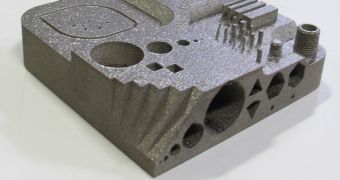There are several 3D printing technologies evolving in parallel, and metal 3D printing is the youngest and most slowly-advancing one, as far as consumer applications are concerned. Now, though, the sector may just make a leap forward instead of a trudge.
Metal 3D printers are opening new ways to design buildings and machines (ground- based and airplanes alike). Eventually, they will probably reach consumers, who will begin to use them for, say, art and everything else done with plastic printing right now.
Cheap metal printers are still impossible to find though, yet this might change soon. The hope was born thanks to San Francisco based company MatterFab, which has just released a metal 3D printer that is one level of magnitude cheaper than any others.
Now, you might be thinking that the MatterFab is meant to operate in the same circles as the €600 / $816 StrongPoint, or that affordable metal 3D printer invented by 17-year-old.
That's not the case. The new powder bed fusion metal 3D printer, the first such printer to reach the US market, is intended as a cheaper but just as effective alternative to the printers used by giants like General Electric and Airbus in, say, aircraft parts.
The machines they use cost around $1 million / €700,000 - €1 million, or even more. Obviously, this isn't something that anyone, normal person or company, can toss out at the first given notice.
The price of the MatterFab 3D printer hasn't actually been spelled out, but an “order of magnitude cheaper” should mean something along the lines of 10% price. Definitely a lot lower than, say, the EBAM launched by Sciaky not long ago.
The powder bed fusion method works like this: metal powder is lain on the print bed, after which a high power laser melts it in precise locations according to a CAD file (computer-aided design). Once the layer is complete, the computer adds a new metal powder layer and repeats the process.
MatterFab has already successfully tested the printer, having used it to make an object back in April 2014. Test partners still need to give their approval, which will happen once the printer is shipped in early 2015.
All in all, it sounds a bit too good to be true, but then again, prosthetic hands that cost $50 / €50 while being better than the standard ones sold for $50,000 / €50,000 sounded too good to be true as well. And yet they have been changing the lives of disable people everywhere, young to old.

 14 DAY TRIAL //
14 DAY TRIAL // 